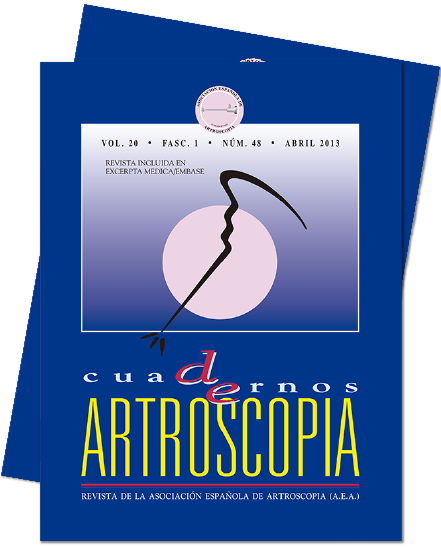Resumen:
Introducción: la luxación recidivante de hombro se ha convertido en una práctica quirúrgica cada vez más frecuente. Pero ¿qué sucede con los pacientes no profesionales que realizan actividad deportiva y que una de las motivaciones para operarse es la limitación para el deporte?
Objetivo: describir en qué grado la reconstrucción en las luxaciones recidivantes de hombro es capaz de restaurar el nivel deportivo no profesional de los pacientes desde su punto de vista subjetivo.
Tipo de estudio: análisis retrospectivo descriptivo de datos prospectivos.
Pacientes y métodos: se revisan 48 casos de inestabilidad glenohumeral anterior operados con reconstrucción de la cápsula anterior con una evolución superior a 20 meses. Los resultados fueron evaluados mediante la escala de Rowe, una EVA y un formulario subjetivo de capacidad de retorno a la actividad deportiva previa recogido telefónicamente.
Resultados: no reluxaciones. Un 62,5% manifestaron su capacidad para retornar a la actividad deportiva previa a la lesión con un nivel similar, si bien tan sólo un 18,75% pudo retornar al nivel previo a la lesión. Un 43,75% atribuían sus limitaciones al miedo a una nueva reluxación.
Conclusiones: los resultados implican no sólo la correcta técnica quirúrgica, sino también otros aspectos, como el apoyo rehabilitador y psicológico.
Abstract:
Introduction: recurrent dislocation of shoulder has become a more often surgical practice. Therefore, what happens with non-professional patients who perform sports activity and that one of the motivations to be operated is the limitation to the sport
Objective: describe to what extent the reconstruction in recurrent dislocation of shoulder is capable of restoring the non-professional sports level of patients from the subjective point of view.
Type of study: descriptive, retrospective analysis of prospective data.
Patients and methods: we review 48 cases of anterior glenohumeral instability operated with reconstruction of the anterior capsule with an evolution of more than 20 months. The results were assessed through the completion of the Rowe scale, a VAS scale and a subjective form of ability to return to previous sports activity collected by telephone interview.
Results: no case of reluxation happened. 62.5% manifest their capacity to return to the sport prior to the injury with a similar level, while only 18.75% could return to the prelesional level. 43,75% attributed their limitations to the fear of a new reluxation.
Conclusions: the results involves not only the correct surgical technique but also other aspects as rehabilitation and psychological support.
Keywords:
Recurrent dislocation
Arthroscopic stabilization
Sport




